At TelescopicWatch, it’s no secret that we love Dobsonians, especially myself. Dobsonian telescopes dominate our rankings due to their excellent performance and almost unparalleled value for the money. And if you’ve read our article on “Why Dobsonians” you’ll understand just why we recommend these telescopes so often. Furthermore, the smaller-aperture tabletop versions of Dobsonians are extremely portable, and many models, such as the Celestron StarSense Explorer and Sky-Watcher Virtuoso GTi series, can be attached to sturdy photo tripods if you need the versatility and adjustments of a tripod.
RELATED: The Best Dobsonian Telescopes
That being said, Dobsonians aren’t for everyone. Let’s go over the alternatives to these telescopes that you can find at a typical consumer price point. This article is not meant for astrophotographers; if you’re interested in astrophotography, you’ll need to pick out a separate optical tube, mount, and assorted equipment.
In this article, we’ll be going over the advantages and disadvantages of some common alternative telescope configurations in comparison to Dobsonians, as well as our top picks for each price category. For more options, our Rankings page is full of telescopes to choose from.
Contents in this article:
Typical Alternative Telescope Designs to Dobsonians
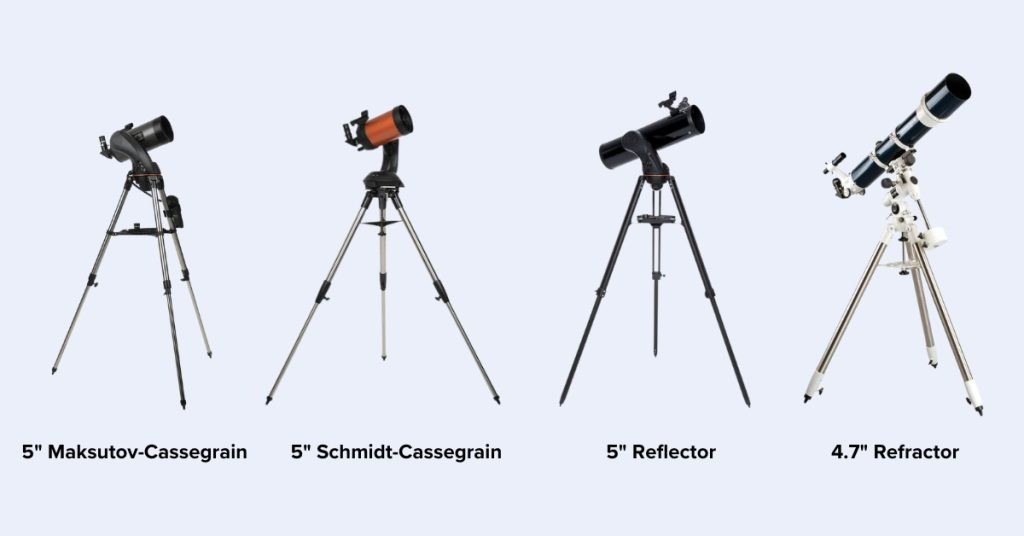
Tripod-Mounted Newtonian Reflectors
Tripod-mounted Newtonian reflectors vary in quality, from disastrously bad Bird-Jones optics and wobbly equatorial mountings to more mechanically and optically sound configurations like the Celestron Astro Fi or Omni XLT telescopes. Most of the time, for a given optical tube, a tripod-mounted Newtonian of any sort will be less steady, more expensive, and less portable than a Dobsonian mounting. But at smaller apertures, you might have an easier time carrying around a tripod than finding a flat surface to set a tabletop Dobsonian scope on.
Top Tripod-Mounted Newtonian Pick By Value: Celestron Astro Fi 130
Refractors
Refractors offer unmatched convenience among telescope designs since they tend to need a negligible amount of time to cool down to ambient outdoor temperature, don’t need collimation, and smaller units can be pretty lightweight.
A small doublet refractor on an alt-azimuth mount is perhaps the closest comparable instrument to wide-field Newtonian/Dobsonian telescopes. Of course, a refractor costs a lot more, inch for inch, than a reflector. But at smaller apertures, this is less of a concern.
The trouble is that unless you either pay for premium optical glass or deal with an obnoxiously long tube (and thus a limited field of view), any refractor you buy is going to suffer from chromatic aberration, which blurs the view, particularly at high magnifications on bright targets. A moderately fast 3-5” achromat (a simple type of refractor that uses a doublet objective lens with crown and flint glass and not any kind of higher-quality ED or fluorite glass) will produce usable views of the planets but is definitely compromised compared to a good longer achromat, apochromat, or a well-made telescope of another optical design.
RELATED: Refractor vs Reflector Comparison
Refractors also don’t scale up so well to larger apertures. Even a short 6” refractor is about as hefty as a typical 8-10” Newtonian/Dobsonian. Longer scopes or those with triplet objective lenses are actually a little bit difficult to hoist up onto their mounts. And of course, these scopes require not only a beefy mount but also a tall tripod/pier to keep the eyepiece above the ground when the scope is pointed high in the sky. A 7” or 8” refractor is the largest you will probably ever see owned by an individual, and these telescopes are hardly portable, as well as typically costing $5–10,000 USD at a minimum.
Yes, refractors punch above their aperture class (a good refractor might provide similarly sharp and bright views to a reflector or catadioptric an inch or two larger in aperture, all else being equal). However, the loss of portability with considerable apertures as well as the extreme cost of these instruments somewhat negate this advantage.
For non-photographic use, the best refractors may have an aperture of 3 to 5 inches. A longer achromatic refractor or an ED doublet can provide great planetary performance in a lightweight, “grab and go” design. Faster scopes can provide great wide-field views of bright deep-sky objects like star clusters, but at higher magnifications, they lose some sharpness and show chromatic aberration.
Top Refractor Pick By Value: Popular Science Celestron StarSense Explorer DX 100AZ
RELATED: The Best Refractor Telescopes
Schmidt-Cassegrains
Schmidt-Cassegrain telescopes (SCTs) are, on paper, unmatched in versatility, offering sharp views of the planets, a wide enough field for some deep-sky observation, and being capable of delivering outstanding images of both Solar System and deep-sky objects. Also, besides Newtonian reflectors and the occasional classical Cassegrain variant, they are the only telescopes that regularly come in apertures larger than 6-7″. This makes them the only realistic and affordable alternative to Dobsonians if you want to get close views of deep-sky objects like globular clusters, galaxies, and planetary nebulae that look best through 8″, 10″ or larger aperture instruments.
Of course, there are inevitable compromises in SCTs’ performance optically, and many units suffer from mediocre or outright bad optics (though this is less of a problem in the modern era). The need for motorized tracking (and preferably a fully computerized GoTo) and larger apertures due to a rather small field of view also makes Schmidt-Cassegrain telescopes more expensive. These motorized mounts can be fairly time-consuming to get set up for a night of observing. The exception is manual equatorial mounts such as the motorized fork mounts many Schmidt-Cassegrains used to be offered on; these can match Dobsonians in overall convenience with the bonus of automatic tracking in most models.
- Top SCT Pick (Value): Celestron NexStar 6SE
- Top SCT Pick (Performance): Celestron Advanced VX 9.25 XLT
RELATED: The Best Schmidt-Cassegrain Telescopes
Maksutov-Cassegrains
Maksutov-Cassegrains offer excellent performance on the Moon and planets and are extremely low-maintenance, requiring collimation only when subject to extreme physical abuse. However, like refractors, they have a bit of a size limit due to the thick crown glass needed for their front corrector lenses. An 8” Maksutov is rare, and units larger than 10” are heavy as well as extremely expensive.
The field of view of these telescopes, owing to their typically long focal ratio of f/12-f/15 and often 1.25”-only eyepiece holders, is also rather limited, even more so than a typical SCT or long refractor. This factor, combined with their lack of aperture, makes them rather poor for viewing deep-sky objects compared to a small wide-field refractor or Newtonian/Dobsonian. A wider field of view makes it easier to find targets, and many star clusters and nebulae span areas of sky larger than the Moon. A telescope with a very long focal length may be unable to fit some objects in the field of view, and it can be much harder to find what you’re looking for if you are using a manual mount or have any errors in pointing accuracy with a GoTo one.
RELATED: Refractor vs Maksutov Comparison
Compared to Schmidt-Cassegrains and refractors, Maksutov-Cassegrains are substantially worse when it comes to thermal management, requiring more time to cool down for optimal performance than any other telescope type owing to their closed nature and the thick glass used for both optical elements. However, their performance is much better than that of a Schmidt-Cassegrain of comparable or slightly larger aperture, or most Newtonians, for that matter.
Top Maksutov Pick By Value: SarBlue Mak70
A scaled-up version of the nifty Mak60, the SarBlue Mak70 comes with a decent alt-azimuth mount and tripod, a true 1.25” rear port, and an acceptable, if basic, set of accessories. It also has razor-sharp optics, as with any Maksutov-Cassegrain telescope. Like the Mak60, however, you don’t get a lot of aperture for your money, and this scope is basically only good for the Moon, planets, and double stars.
RELATED: The Best Maksutov-Cassegrain Telescopes
Best Non-Dobsonian Telescopes: Our Picks
Under $150: Orion SpaceProbe II 76mm
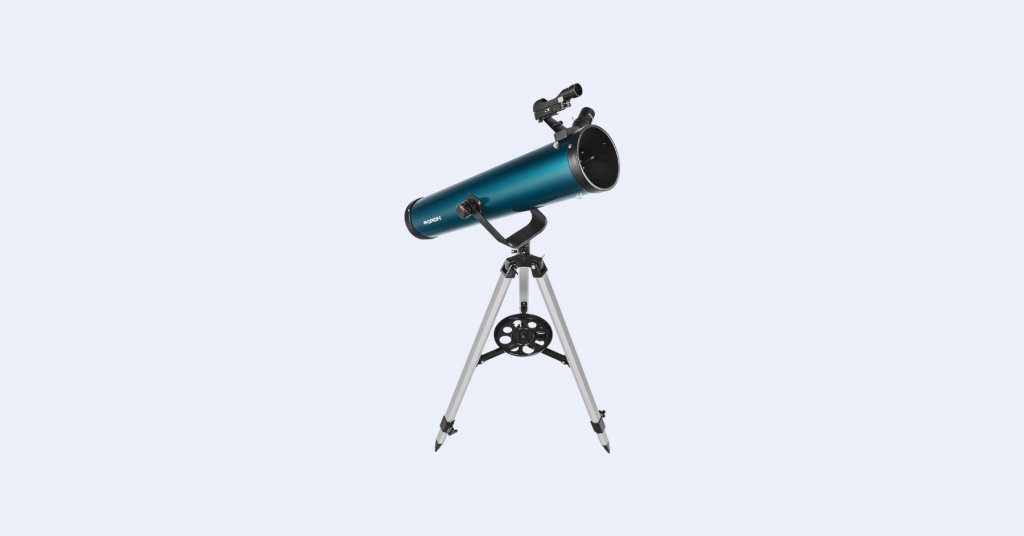
- Sharp 76mm Newtonian optics for close-ups of the Moon and planets as well as recognizable views of the brightest deep-sky objects
- Reasonably sturdy equatorial mount and tripod
- Decent included Kellner eyepieces and red dot finder
Specs:
- Type of telescope: Newtonian Reflector
- Aperture: Its 76mm (3”) f/9.2 Newtonian reflecting optics suffer from none of the chromatic or spherical aberrations of many of the flawed telescopes sold at this price point.
- Accessories: The included eyepieces are satisfactory enough to get you started.
- Mount: Tripod-Mounted German Equatorial
While mounted on a spindly equatorial mount like many of the “hobby killers” in its price range, you can trust that the Orion SpaceProbe II 76mm is reasonably sturdy.
The SpaceProbe II 76mm is an okay telescope, but it’s worth instead considering investing a bit more in a larger (100mm or more) tabletop Dobsonian with greater simplicity, stability, and a larger aperture offering greater resolution and light-gathering power. You might also be better off with a pair of 7×50 or 10×50 astronomy binoculars if your interests lie more outside the Solar System.
RELATED: Orion SpaceProbe II 76EQ Review
$150-$250 Choice: SarBlue Mak70
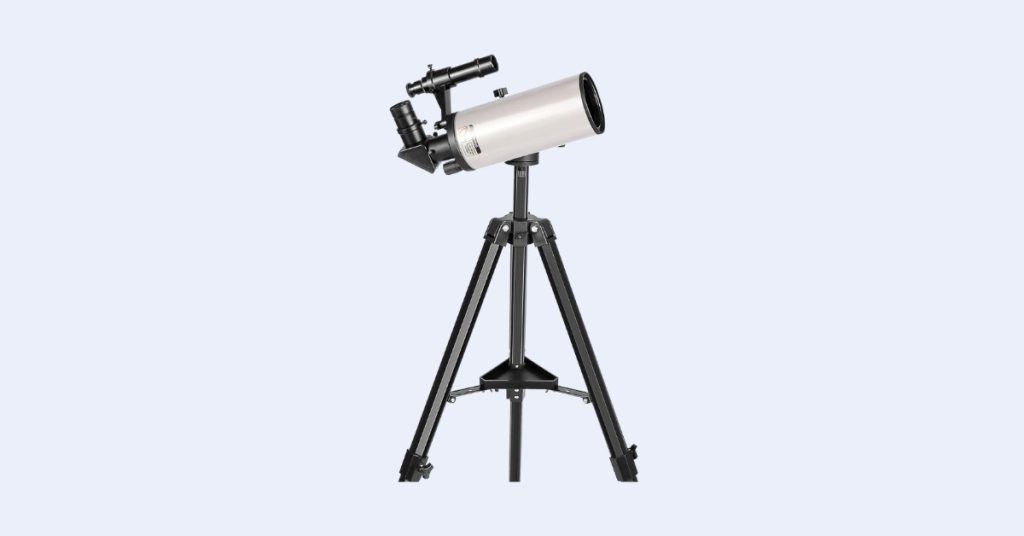
- Lightweight, compact 70mm Maksutov-Cassegrain optical tube is no bigger than a beverage can
- Sharp optics
- Quality included accessory set
- Sturdy alt-azimuth mount/tripod
Specs:
- Type of telescope: Maksutov Cassegrain
- Aperture: With a 70mm aperture, it is well-suited for lunar, planetary, and double star observations, offering clear and crisp images of the Moon’s craters, Saturn’s rings, and Jupiter’s moons.
- Accessories: The Mak70 also includes a set of 2 eyepieces and a Barlow lens, along with a fairly steady tripod, though if you’re dissatisfied with the supplied tripod, the Mak70’s mount head will fit any photo tripod with a ⅜” stud on top.
- Mount: Tripod-Mounted Alt-azimuth Fork
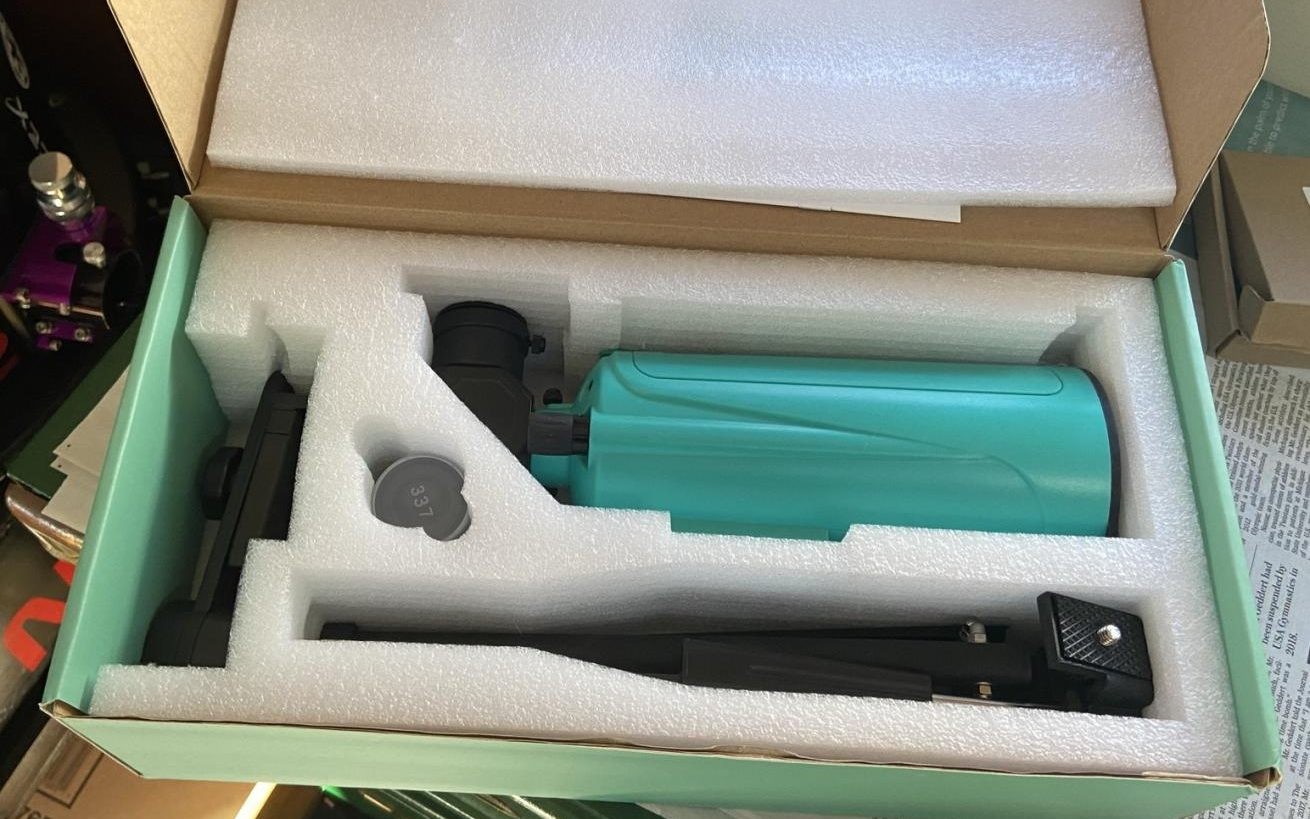
The SarBlue Mak70 is a compact and portable Maksutov-Cassegrain telescope, perfect for beginners and those who value mobility in their stargazing endeavors. In terms of actual performance, it is not much different from the Orion SpaceProbe II 76mm; however, the Mak70 is significantly more compact, sturdy, robust, and easy to use than the SpaceProbe II.
The Mak70 is unrivaled in its portability thanks to its Maksutov-Cassegrain configuration and the minimalist nature of its mounting; the optical tube and mount head are each no bigger than a 20-ounce beverage can. However, its tiny field of view and lack of aperture mean it falls short when it comes to deep-sky viewing; there is next to nothing of interest to see besides a few of the brightest star clusters.
RELATED: SarBlue Mak70 Review
$250-$400: Popular Science Celestron StarSense Explorer DX 100AZ Refractor
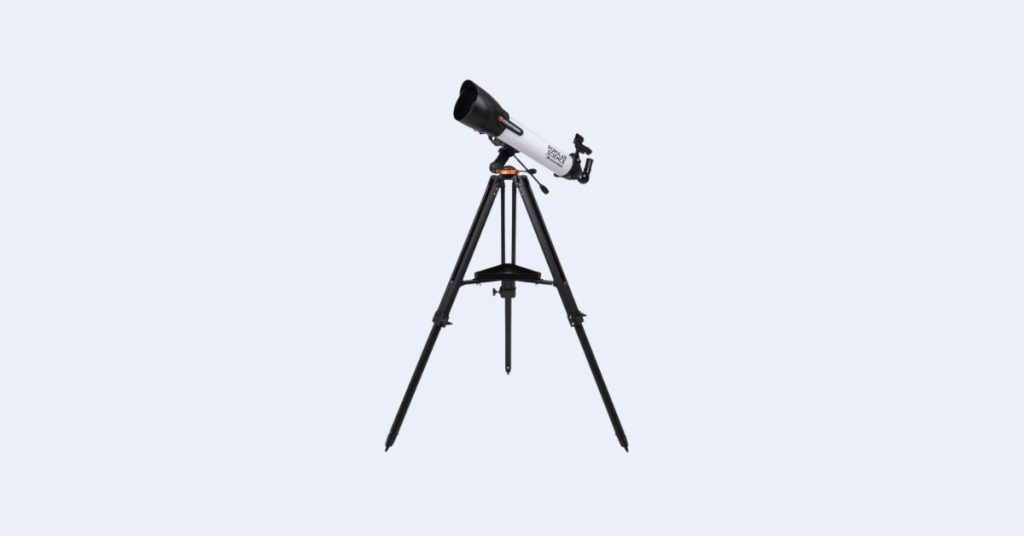
- StarSense Explorer tech to aid in navigating the night sky with your smartphone
- 4” refractor optics provide ok planetary, deep-sky views
- Simple alt-azimuth mount/tripod
Specs:
- Type of telescope: Refractor
- Mount: Tripod-Mounted Alt-azimuth Fork
The Popular Science Celestron StarSense Explorer DX 100AZ is a fast (f/6.6) 4” achromatic refracting telescope atop a manual alt-azimuth mount and tripod. It also features Celestron’s StarSense Explorer technology, which consists of a bracket and software to utilize your smartphone’s camera and internal gyroscopes to find where the telescope is pointed in the sky to help you find your way to deep-sky objects.
While its 4” objective lens provides comparable light-gathering and resolving power to 5” reflectors and catadioptrics, the StarSense Explorer DX 100AZ does have a fair bit of chromatic aberration, being an optically “fast” f/6.6 achromat. This is a compromise of nearly all refractors, especially the more affordable achromats. It produces noticeable purple halos on bright objects like the Moon and planets which does affect sharpness at higher magnifications. However, the planetary views with this telescope are still pretty satisfactory.
RELATED: Popular Science Celestron StarSense Explorer DX 100AZ Review
$400-$750: Celestron Astro Fi 130 Computerized Reflector
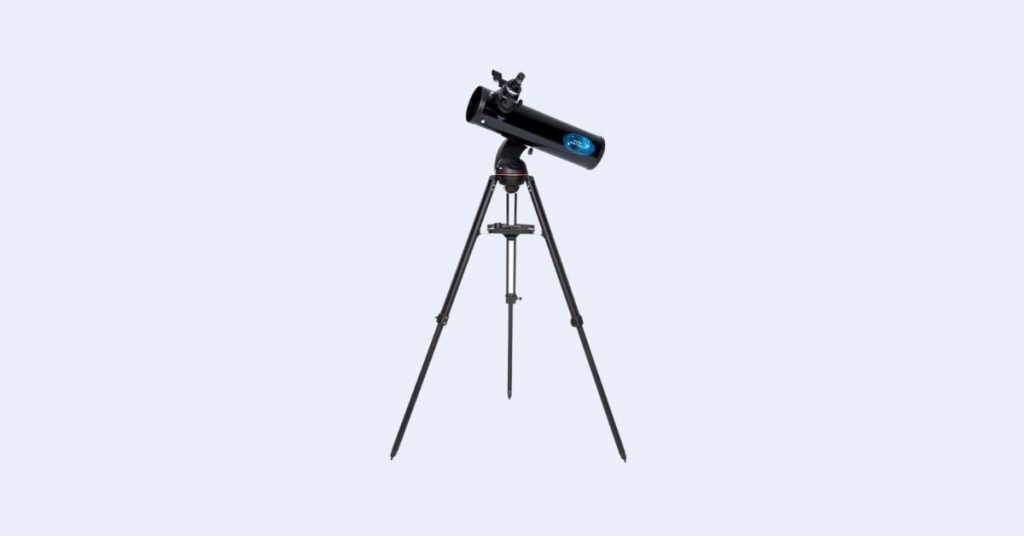
- 130mm f/5 optics and 2” focuser for excellent wide-field views
- Decent planetary performance
- Lightweight GoTo Astro-Fi mount is easy to operate via your smartphone/tablet
- Sturdier than 130SLT model and more up-to-date technology
Specs:
- Type of telescope: Reflector
- Mount: Tripod-Mounted Alt-azimuth Fork GoTo
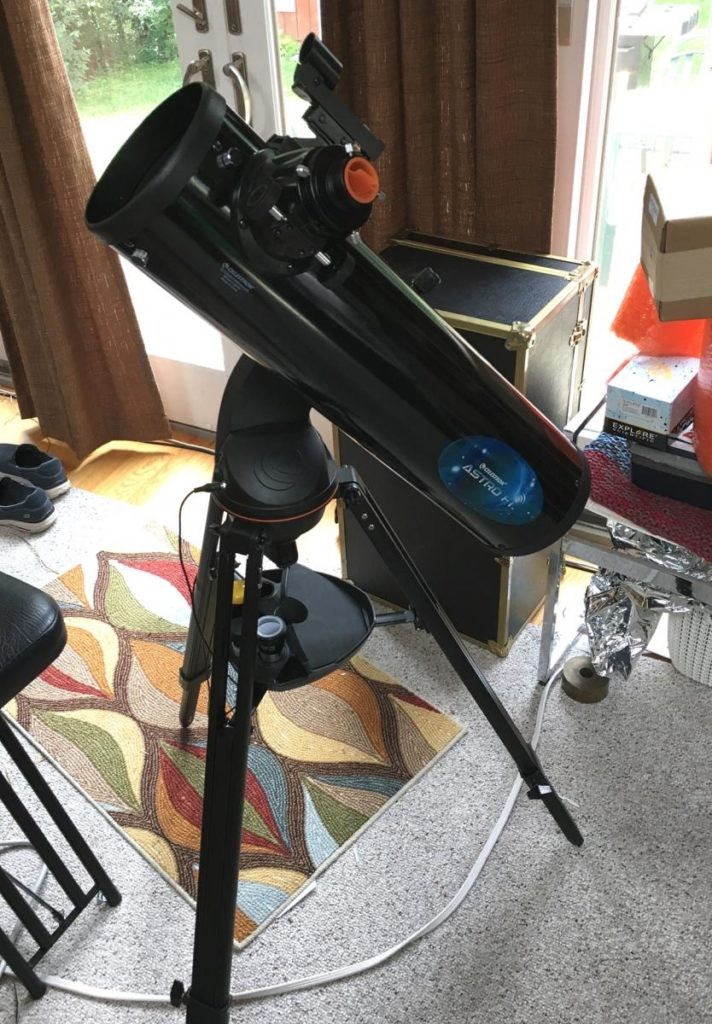
The Celestron Astro Fi 130, while not as powerful as a 6” or 8” Dobsonian, is certainly an agreeable pick in its price range. Its computerized GoTo mount, controlled via your smartphone or tablet, automatically locates and tracks celestial objects. The Astro Fi 130 is essentially an improved version of the NexStar 130SLT and SkyProdigy 130 models also offered by Celestron; these models have a substantially worse mount/tripod and offer no advantages over the Astro Fi 130 model and thus are not recommended.
The Astro Fi 130’s 130mm f/5 Newtonian optical tube matches other 130mm f/5s on the market in performance, providing a substantial 5.1 inches of aperture suitable for deep-sky, lunar, and planetary observation. With a 650mm focal length and a 2” focuser, it offers the potential for a wide field of view too, ranging from 2.1 degrees with the included 25mm Kellner eyepiece to potentially 3.5 degrees with a 2” eyepiece adapter.
The Virtuoso GTi 130P, a computerized tabletop Dobsonian from Sky-Watcher offers the same smartphone-controlled GoTo and 130mm f/5 optics as the Astro Fi 130, with the bonuses of a collapsible tube, the ability to be aimed manually, and a lower price tag. It fits on any ⅜” socket. The same is true of the larger 150P model, which offers better performance. We highly recommend considering these telescopes, though they are Dobsonians, before settling on the Astro FI 130.
RELATED: Celestron Astro Fi 130 GoTo Review
$750-$1200: Celestron Nexstar 6SE GoTo
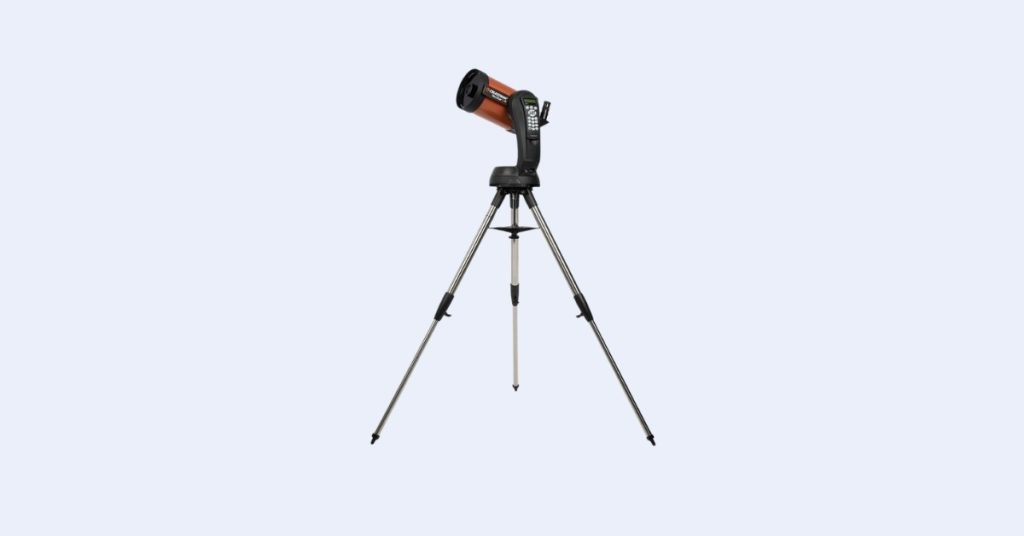
- 6” Schmidt-Cassegrain optics provide excellent planetary performance and good deep-sky views
- Some astrophotography capabilities
- Sturdy GoTo mount/tripod
Specs:
- Type of telescope: Schmidt-Cassegrain
- Mount: Tripod-Mounted Alt-azimuth Fork GoTo
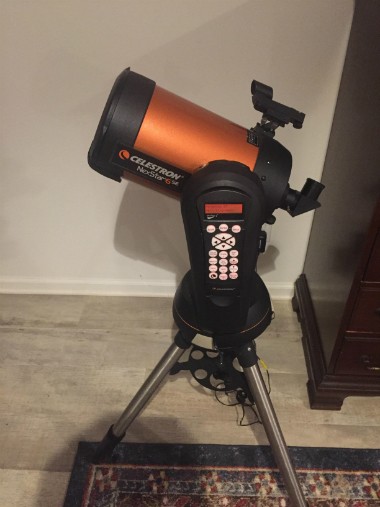
The Celestron NexStar 6SE, part of the NexStar SE series, is a well-regarded choice and provides the best performance for the price among its catadioptric siblings. Offering a 6” (150mm) aperture, it combines quality optics with a sturdy GoTo mount, making it suitable for observing the Moon, planets, and a significant number of deep-sky objects. While its f/10 focal ratio and 1500mm focal length offer a more restricted field of view than fast Dobsonians, it excels in planetary astrophotography and can be adapted for deep-sky imaging atop a different mount with an f/6.3 reducer or f/2 Hyperstar adapter.
The NexStar 6SE is a GoTo telescope, but the interface is a little outdated compared to many other GoTo mountings. This is mainly because the 6SE has been on the market for 15 years with no changes—you still have to use the provided hand controller to operate the mount unless you spend extra on an aftermarket WiFi dongle, and there is no way to aim the telescope manually. However, it works quite well once you’ve got the mount set up and aligned.
RELATED: Celestron NexStar 6SE Review
$1200-$1600: Celestron NexStar Evolution 6 Computerized
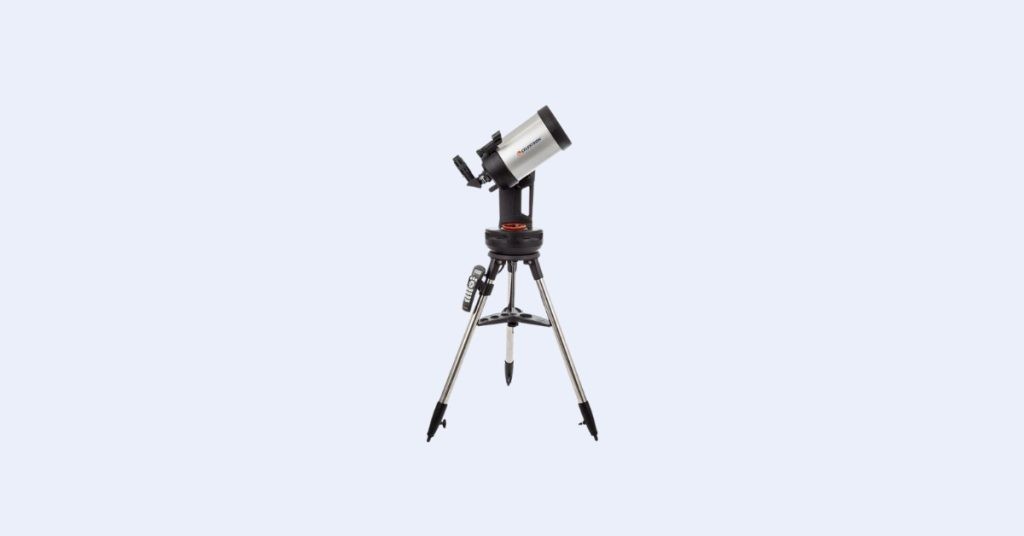
- Improved mount/tripod compared to NexStar 6SE features built-in battery, WiFi, clutches
- C6 XLT optical tube provides same sharp views and astrophotography capabilities as NexStar 6SE model
- Lightweight and portable
Specs:
- Type of telescope: Schmidt-Cassegrain
- Mount: Tripod-Mounted Alt-azimuth Fork GoTo
The NexStar Evolution 6 uses the same C6 XLT optical tube as the NexStar 6SE and, at first glance, appears quite similar. Both telescopes use similar alt-azimuth GoTo mounts and are even supplied with the same hand controller. However, the Evolution 6 boasts a more robust mount head featuring an all-metal construction with a built-in battery and a WiFi dongle to operate the telescope via your smartphone or tablet (a $100+ add-on for the 6SE and other scopes). These upgrades make the Evolution quite a bit more convenient than the 6SE to set up. The Evolution 6 also includes two eyepieces instead of one to get you started, though at this price point, such differences are irrelevant and you will still want to order some additional aftermarket eyepieces anyway.
RELATED: Celestron NexStar Evolution 6 Review
$1600-$2250: Celestron NexStar Evolution 8 Computerized
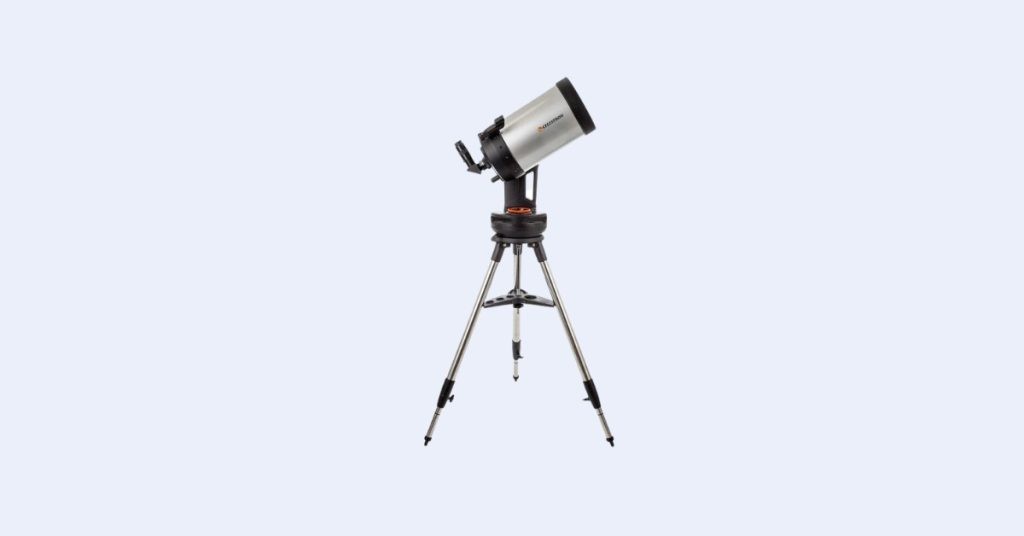
- Large 8” aperture provides excellent views of Moon, planets, deep-sky objects
- Built-in battery and WiFi
- Lightweight, compact fork mount and sharp Schmidt-Cassegrain optics
Specs:
- Type of telescope: Schmidt-Cassegrain
- Mount: Tripod-Mounted Alt-azimuth Fork GoTo
The NexStar Evolution 8 utilizes Celestron’s iconic 8” Schmidt-Cassegrain (C8) telescope optical tube. The original C8 design, dating back to the 1960s, has largely remained consistent in performance over the decades, with updates primarily in optical coatings and manufacturing techniques. The Evolution 8 pairs this telescope optical tube with the NexStar Evolution mount, which offers fully motorized pointing/tracking that can be controlled via the included hand set or your smartphone/tablet over the mount’s built-in Wi-Fi network. There’s also a built-in rechargeable lithium-ion battery.
The C8 XLT optical tube can be used atop the provided NexStar Evolution mount for viewing, lunar/planetary imaging, and even some deep-sky astrophotography when paired with a reducer and wedge, though a different mounting with an equatorial configuration like the Sky-Watcher EQ6Ri Pro would be a better choice for this task with the C8.
The NexStar Evolution 8 is available both as the base model and a deluxe version with upgrades like EdgeHD optics for astrophotography and the StarSense Auto-Align add-on, though these enhancements don’t significantly impact the telescope’s visual performance.
Compared to its lower-priced counterpart, the NexStar 8SE, the Evolution 8 offers the same optics but substantially better quality construction, translating to steadier views at the eyepiece and a more user-friendly experience thanks to its more robust mount head, integrated WiFi, battery, and less use of plastic parts.
RELATED: Celestron NexStar Evolution 8 Review
$2250-$3000: Celestron Advanced VX 9.25″ Schmidt-Cassegrain
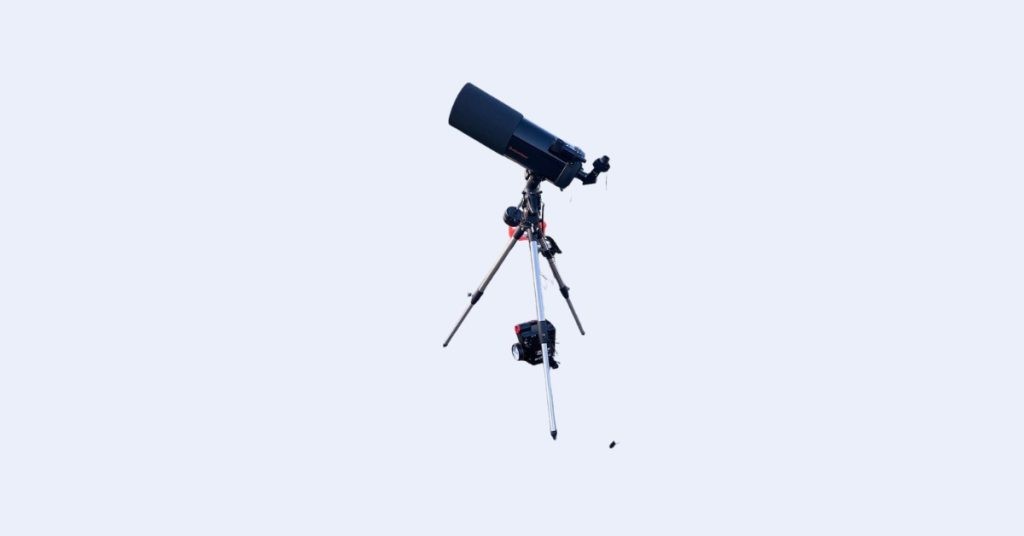
- Slightly better performance than 8” without much of a step up in bulk
- Easily dismantled into lightweight and compact sub-components
- Advanced VX mount can be used with a different telescope for deep-sky astrophotography
Specs:
- Type of telescope: Schmidt-Cassegrain
- Mount: Tripod-Mounted Alt-azimuth Fork GoTo
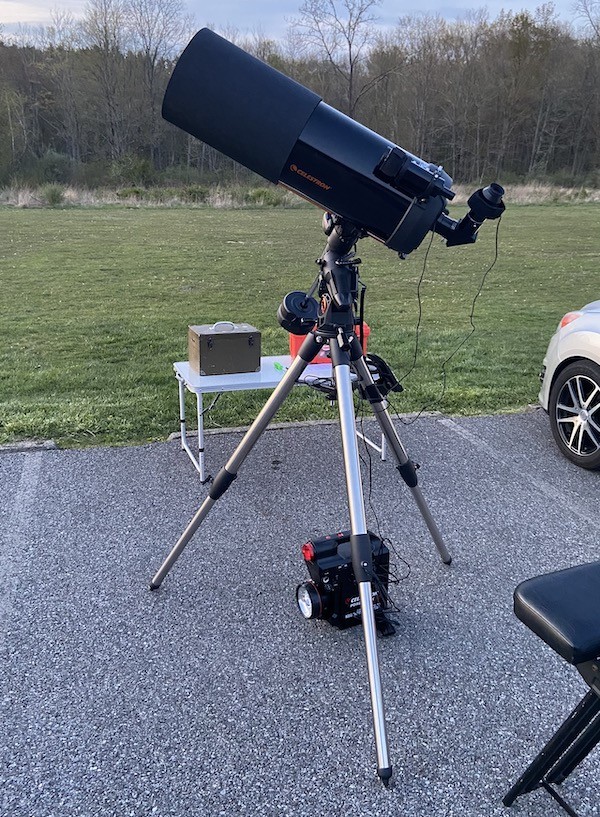
The Celestron Advanced VX 9.25” SCT is one of the largest telescopes Celestron offers with the Advanced VX GoTo equatorial mount. This combination, presenting a more practical alternative to the bulkier and less stable NexStar Evolution 9.25, is one of the largest easily transported telescopes that isn’t a Dobsonian. The C9.25 XLT optical tube excels in planetary viewing and imaging and puts up excellent views of smaller deep-sky objects, too. While it might be ¾” smaller than a 10” Dobsonian, the difference side-by-side is negligible. The C9.25 XLT is an excellent telescope for viewing all types of objects, apart from the largest nebulae and star clusters, which do not fit in its field of view. It’s not much heavier or bulkier than a C8 either, which is why it’s able to fit atop the relatively lightweight Advanced VX mount.
Unfortunately, the Advanced VX mount is far too small to support deep-sky astrophotography with the C9.25 optical tube, owing to its long focal length and weight. A much larger and sturdier mount, like the Losmandy G11, would be required, and the EdgeHD configuration of the C9.25 would be preferable for this task. However, the Advanced VX can be used with a smaller telescope, such as an 80mm refractor or 6” Newtonian, for deep-sky astrophotography; the universal Vixen-style dovetail system allows you to interchange any telescope in place of the C9.25 as you wish.
RELATED: Celestron Advanced VX 9.25 Review

